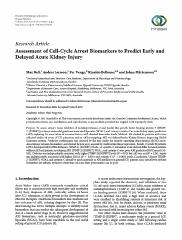Please use this identifier to cite or link to this item:
https://ahro.austin.org.au/austinjspui/handle/1/12734Full metadata record
| DC Field | Value | Language |
|---|---|---|
| dc.contributor.author | Bell, Max | en |
| dc.contributor.author | Larsson, Anders | en |
| dc.contributor.author | Venge, Per | en |
| dc.contributor.author | Bellomo, Rinaldo | en |
| dc.contributor.author | Mårtensson, Johan | en |
| dc.date.accessioned | 2015-05-16T02:28:00Z | |
| dc.date.available | 2015-05-16T02:28:00Z | |
| dc.date.issued | 2015-03-18 | en |
| dc.identifier.citation | Disease Markers 2015; 2015(): 158658 | en |
| dc.identifier.govdoc | 25866432 | en |
| dc.identifier.other | PUBMED | en |
| dc.identifier.uri | https://ahro.austin.org.au/austinjspui/handle/1/12734 | en |
| dc.description.abstract | To assess urinary tissue inhibitor of metalloproteinases-2 and insulin-like growth factor binding protein 7 ([TIMP-2]·[IGFBP7]), urinary neutrophil gelatinase-associated lipocalin (NGAL), and urinary cystatin-C as acute kidney injury predictors (AKI) exploring the association of nonrenal factors with elevated biomarker levels.We studied 94 patients with urine collected within 48 hours of ICU admission and no AKI at sampling. AKI was defined by the Kidney Disease: Improving Global Outcomes criteria. Predictive performance was assessed by the area under the receiver operating characteristics (ROC) curve. Associations between biomarkers and clinical factors were assessed by multivariate linear regression.Overall, 19 patients (20%) developed AKI within 48 hours. [TIMP-2]·[IGFBP7], NGAL, or cystatin-C admission levels did not differ between patients without AKI and patients developing AKI. [TIMP-2]·[IGFBP7], NGAL, and cystatin-C were poor AKI predictors (ROC areas 0.34-0.51). Diabetes was independently associated with higher [TIMP-2]·[IGFBP7] levels (P = 0.02) but AKI was not (P = 0.24). Sepsis was independently associated with higher NGAL (P < 0.001) and cystatin-C (P = 0.003) levels.Urinary [TIMP-2]·[IGFBP7], NGAL, and cystatin-C should be used cautiously as AKI predictors in general ICU patients since urine levels of these biomarkers are affected by factors other than AKI and their performance can be poor. | en |
| dc.language.iso | en | en |
| dc.title | Assessment of cell-cycle arrest biomarkers to predict early and delayed acute kidney injury. | en |
| dc.type | Journal Article | en |
| dc.identifier.journaltitle | Disease markers | en |
| dc.identifier.affiliation | Section of Anaesthesia and Intensive Care Medicine, Department of Physiology and Pharmacology, Karolinska Institutet, 17176 Stockholm, Sweden ; Department of Intensive Care, Austin Hospital, Heidelberg, Melbourne, VIC 3084, Australia | en |
| dc.identifier.affiliation | Department of Intensive Care, Austin Hospital, Heidelberg, Melbourne, VIC 3084, Australia ; Australian and New Zealand Intensive Care Research Centre, School of Preventive Medicine and Public Health, Monash University, Melbourne, VIC 3800, Australia | en |
| dc.identifier.affiliation | Section of Anaesthesia and Intensive Care Medicine, Department of Physiology and Pharmacology, Karolinska Institutet, 17176 Stockholm, Sweden. | en |
| dc.identifier.affiliation | Clinical Chemistry, Department of Medical Sciences, Uppsala University, 751 85 Uppsala, Sweden. | en |
| dc.identifier.doi | 10.1155/2015/158658 | en |
| dc.description.pages | 158658 | en |
| dc.relation.url | https://pubmed.ncbi.nlm.nih.gov/25866432 | en |
| dc.type.austin | Journal Article | en |
| local.name.researcher | Bellomo, Rinaldo | |
| item.openairecristype | http://purl.org/coar/resource_type/c_18cf | - |
| item.fulltext | With Fulltext | - |
| item.grantfulltext | open | - |
| item.languageiso639-1 | en | - |
| item.openairetype | Journal Article | - |
| item.cerifentitytype | Publications | - |
| crisitem.author.dept | Intensive Care | - |
| crisitem.author.dept | Data Analytics Research and Evaluation (DARE) Centre | - |
| Appears in Collections: | Journal articles | |
Files in This Item:
| File | Description | Size | Format | |
|---|---|---|---|---|
| 25866432.pdf | 1.54 MB | Adobe PDF |  View/Open |
Page view(s)
28
checked on Feb 28, 2025
Download(s)
106
checked on Feb 28, 2025
Google ScholarTM
Check
Items in AHRO are protected by copyright, with all rights reserved, unless otherwise indicated.
